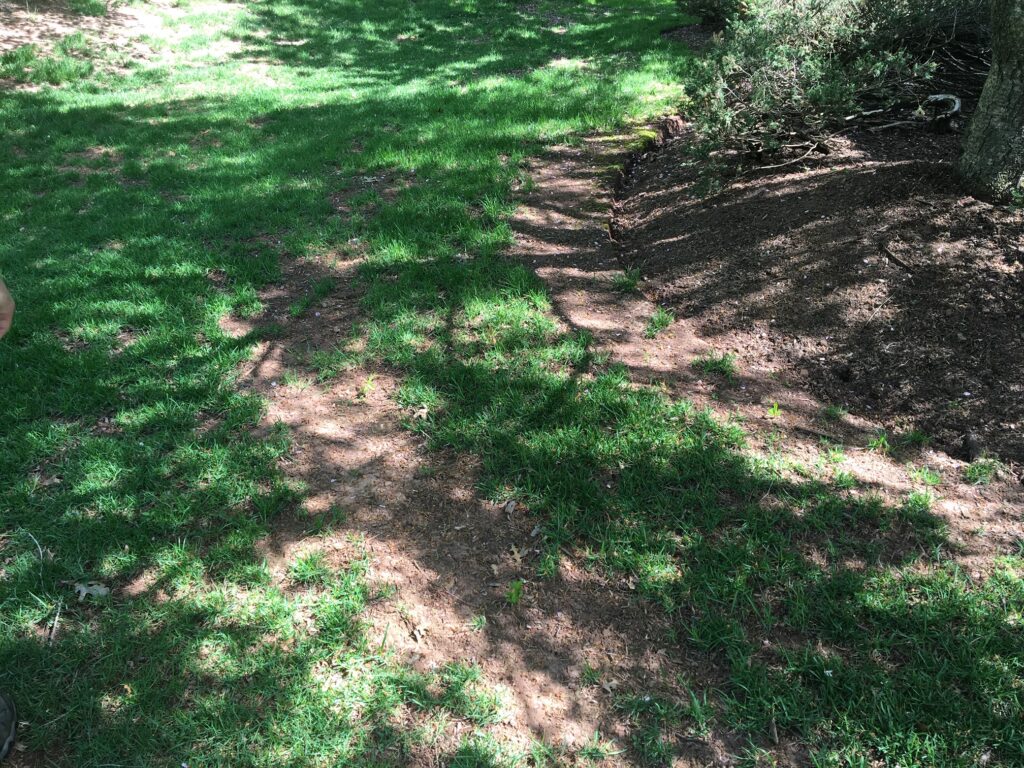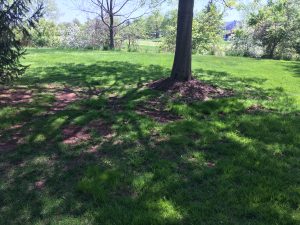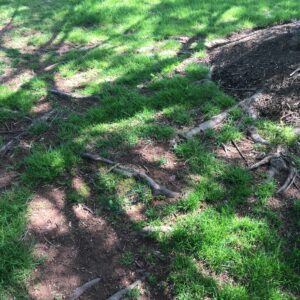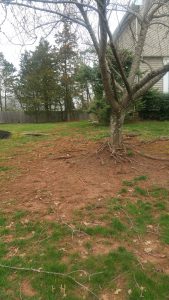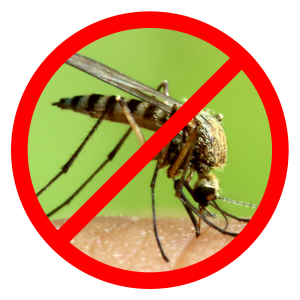Category Archives: Yard Maintenance
Property Aging, Soil Compaction and Erosion
It is believed that 35 million years ago the Colorado River flowed over what was then nothing more than a vast plain. However, after hundreds of millennia the river carved a giant trench into the earth’s surface more than 5000 feet deep and 277 miles long. This great trench we now call The Grand Canyon was shaped by two of the most powerful forces known to man; erosion and time. Over time, use and forces of Nature shape all land areas including the lawn and landscape.
It’s Just Common Sense
That bit in the opening about the Grand Canyon was something we probably all learned in grade school and haven’t thought much about erosion since then. Just because we haven’t thought about erosion in the last decade or so doesn’t make it any less true. We haven’t thought about the periodic table in just as long, but the elements still exist. Erosion is every bit as real as copper, gold, and silver, and no surface on this earth is immune to its influence.
Aging on the other hand is something we can all appreciate. As time passes, everything from our cars to our cell phones, to our own bodies start to wear out. Our properties are not any different. In fact, if you think about it, it’s remarkable that they last as long as they do. Cars have garages, cell phones have cases, and we have clothes and homes. What does the property have to shield itself from the elements? Now you may not live on the same parcel of land for as many millennia as it takes to see a canyon form, but it is reasonable to understand that wear and tear happens, even to our properties.
Soil Compaction
The quality of the soil and the long-term health of the lawn go hand in hand. In central New Jersey there is predominantly clay soil, so one of the main concerns is soil compaction. Clay soil holds water and remains soft for extended periods following irrigation or rain fall. While in this state the soil can easily compress, especially within the top inch or two. Over time, the soil becomes compacted and it makes it very difficult for oxygen and water to reach the root zone where it is needed. If soil compaction goes unaddressed for too long, plants suffer due to lack of oxygen. As a result, the grass cannot recover from even moderate stress, and eventually ground cover is lost as plants slowly die off.
Soil compaction becomes an issue more quickly in areas that receive higher amounts of traffic. Areas in and around children’s swing sets, near gates, portions of the lawn near the perimeters of beds where mowers make turns, areas in front of entrance/exit to decks or porches, corners of driveway/walkway that are cut across on foot, are all areas where soil compaction stress is accelerated. The grass recovery cannot outpace the stress that occurs, and these areas thin out more quickly than open sections of the property that receive less traffic.
Trees
We have established that lack of oxygen in the soil can lead to the decline in grass health as a result of soil compaction and that the clay soil has a tendency to hold moisture. In open areas the direct sunlight evaporates moisture from the soil surface. This allows oxygen to enter microscopic pore spaces between the soil’s particles so that the roots can “breathe”. The health of the grass depends on this influx of oxygen between irrigation and rainfall.
Without being able to take in the oxygen, the grass suffocates and under-performs. Within the shade of tree canopies, the moisture remains inside the micro-pores of the soil for too long, and the roots don’t receive enough oxygen. The clay soil also remains softer for longer, which accelerates compaction. As time passes, trees become larger and more mature, their canopies shade more surface area, and the amount of lawn affected becomes more extensive.
The lack of direct sunlight also interferes with the ability of the grass to photosynthesize. Plants use the sunlight, carbon dioxide and water to produce carbohydrates in order to live. The sunlight filtered through the leaves of the trees is not enough to support the grass beneath, and so it suffers.
Moreover, the tree roots also compete with the grass for beneficial soil nutrients. As the trees mature, their nutrient requirements increase, and their roots reach further across the property to support the demand. As a result, the same tree can impact a much larger area than it had previously.
Erosion
A lot of people may forget that the relationship between the soil and the grass is symbiotic. Most everyone understands that the grass depends on the soil as a medium in which to set its roots and grow. The soil’s ability to hold moisture and nutrients is essential for the plants. However, the soil also relies on the plant roots to give it stability as well as absorb excess moisture. Without established ground cover, soil becomes very unstable and as rainfall or irrigation occurs, the soil washes away a little at a time.
Properties are designed to shed water away from buildings, so there is always water movement over the soil surface following rain or irrigation. We do our best with landscaping to minimize the effects of erosion, but over time this process can take a significant toll on the property. In wetter regions such as ours that receive higher amounts of annual rainfall, the effects of erosion can be very substantial from one year to the next.
What to do
To minimize the negative effects of soil compaction, the lawn should be core aerated at least every other fall. This process of removing plugs from the soil and allowing them to resettle alleviates the compacted clay. As a result, the grass plants receive ample oxygen to support dense, healthy root growth. The fibrous root growth in turn helps maintain the integrity of the soil structure and discourage soil loss from erosion.
What better way to reverse the aging process than bringing in new life! Seed whenever necessary to re-establish ground cover. Do not allow thin areas to become bare areas and incorporate higher quality newer turf blends whenever possible. Newer grass varieties have better resistance to drought stress and disease which will provide more durable long-lasting ground cover.
Also, work with a landscaper to minimize erosion by directing water shed through areas least vulnerable to soil loss. For example, you can run downspouts into underground drainpipes or into gravel areas so that water doesn’t flow over the soil surface or settle in low points of the lawn. As trees mature and roots become exposed install more durable ground cover to keep it from getting worse. Any combination of mulch, stone, and low-lying shrubs can be used to create long-lasting, functional, and attractive features to the landscape that will prevent erosion.
Irrigate the lawn deeply and infrequently to promote root growth. Most lawns with clay soil should be watered heavily every fourth day. Frequent watering can cause disease and shallow rooting if done lightly and can promote erosion and serious oxygen deprivation when done heavily. Irrigation cycles should be spread out to allow the moisture enough time to move deeply into the soil. Depending on the weather and how well your property drains, irrigation may only need to be run once every 7-10 days.
Additionally, we recommend promoting dense turf growth through fertilization. Keeping the grass well fed will give it the capability to recover from stress. Without vigorous turf growth, stress from traffic, disease, drought, and insects can cause significantly more permanent damage and loss of ground-cover.
Conclusion
Despite your best efforts, at times deterioration can occur. Most of the time this isn’t because you’re doing anything particularly wrong, or your landscaper doesn’t know what they’re doing. These things happen because your lawn is exposed to a myriad of different types of stress in an ever-evolving environment, and sometimes it just can’t keep up even with your help. The best that you can do is institute sound cultural practices and accept that like any other living thing, the lawn will require additional care as it ages.
If you are in our service area and would like more advice about your lawn and landscape, request a free estimate online, or give our office a call at 908-281-7888.
Lawn Watering Schedule
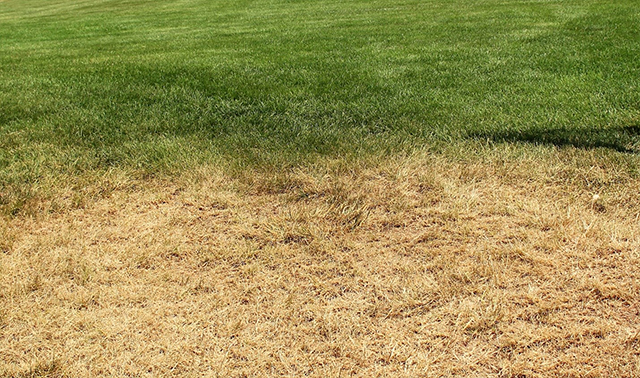
Summer is in full swing and the warm weather makes it perfect to enjoy your outdoor living space. Unfortunately, the same warm weather and lack of rain can really stress your lawn. Maintaining a lawn and landscape takes a lot of work and effort, but there are few cultural practices that are important to keep your lawn looking great throughout the summer.
In addition to following our mowing best practices, another summer cultural practice that will greatly improve the look of your lawn is to implement a lawn watering schedule. When executing a lawn watering schedule, we highly stress sticking to a schedule. Rotating between watering and not watering can weaken the glass plant. Additionally, these recommendations are for the soil types with a considerable amount of clay in them. For sandy soil, the watering recommendation will be completely different.

This image captures the difference between a lawn properly watered and a dormant lawn.
Lawn Watering Schedule
The best time to water your lawn is between the hours of 12 am and 6 am. This helps minimize water loss to evaporation because this time of the day is often cooler and more humid. This also allows the water to penetrate deeper into the soil and minimizes the length of time the grass blades remain wet, since the blades will already be covered in dew. This helps reduce the susceptibility for turf diseases.
Frequency of Watering
We recommend watering your lawn like a heavy rainstorm; putting a lot of water down at once! It is important to water in a way that will reach the depth of the turf’s root system. A good starting point in our area is to provide 1 inch of water per week. For underground irrigation systems, you want to have your system set to run 1 – 1 ½ hours twice a week.
If you have hose-end sprinklers, we recommend purchasing a valve timer and setting your sprinkler to run for 4 hours, once per week. These run times are approximations to get you to 1 inch of water per week, the timing may vary slightly depending on the type of sprinklers installed.
If your following the watering schedule and your soil is still drying out and you notice browning, try adding an extra half hour of run time to each zone. Always start by adding time to the current watering schedule, rather than adding another day.
Frequent and short watering (15 minutes per zone everyday) is not a good lawn watering schedule. It will promote a shallow root system which can weaken the grass plant and encourages disease. Unfortunately, this is something we come across quite often. Deep, infrequent watering is recommended and will help create a deeper root system, resulting in a stronger grass plant.
Conclusion
Once a lawn goes dormant, it will take a few weeks of good watering for the grass to exit dormancy. Therefore, it is important to start watering early in the year and not stop. If you keep up with the watering schedule, your turf will have plenty of moisture over the entire summer.
Summer is a great time to spend outside but can be very stressful on your lawn. Following a few cultural best practices can really make a difference when it comes to having a healthy lawn all summer long. If you have any questions about summer cultural practices or want more information about a lawn watering schedule, please request an online estimate or give our office a call at 908-281-7888.
What is the Right Grass Mowing Height?
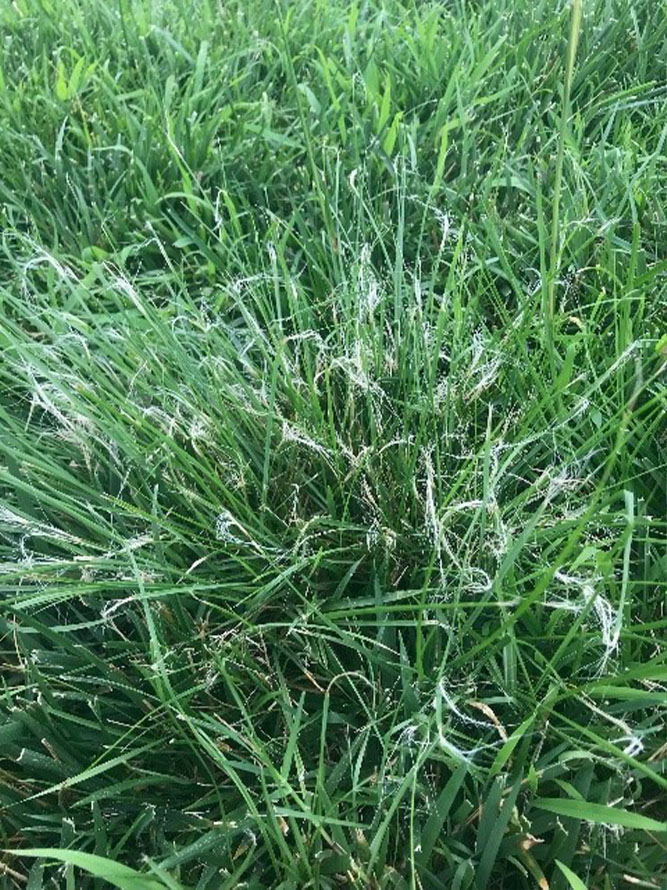
Here in New Jersey, summer time has arrived; and now is the time to enjoy your outdoor living space. There are many ways to make your outdoor property look great this summer, including your lawn. Maintaining a lawn and landscape takes a lot of work and effort, but there are few cultural practices that are important to keep your lawn looking great throughout the summer.
To start, here in New Jersey we deal primarily with northern turf grass species. This includes Rye grass, Blue grass, Tall Fescue, Fine Fescues and Chewing Fescue turf varieties. Our below recommendations to follow are averages that can be used by a homeowner to cover norther turf grass species.
One of the very first cultural practices is proper mowing. It may seem like an easy task, just take your mower out of the shed, and go to town on your lawn. There’s a little bit more to it than that, like knowing the right grass mowing height. Below we will go through several mowing best practices.
Grass Mowing Height
Proper grass mowing height and proper frequency is essential to the health of your lawn. The best grass mowing height in our area is about 3 – 3 ½ inches in length. When mowing the lawn, mow off only 1/3 of the grass plant at a time. We recommend frequency of mowing should depend on how tall the grass is, and not necessarily following a calendar schedule. For example, if a lawn is being kept at 3 inches in height, it should be mowed when the grass reaches 4 ½ inches, not every other Wednesday. By removing too much of the grass blade at one time, it can weaken the plant which in turn will reduce its ability to withstand other environmental issues such as disease, surface feeding insects and even invasion of broadleaf weeds.
Also, be very careful not to cut the lawn too short or weedwack the edges too close. This is commonly referred to as scalping. Scalping is when too much of the grass blade is mowed off at one time and the stem and crown of the plants are left exposed. Scalping a lawn whether it is from mowing too short or uneven ground can cause injury to the plant. Raising the mower blades higher will help reduce this problem and watering properly helps aid in recovery of scalped areas. Sometimes seeding is needed to repair permanently damaged scalped areas.
When finding the best grass mowing height, it is best to keep the grass tall. Keeping it tall will help shade the soil under the turf canopy and keep the soil cooler. This will help to reduce the number of weeds that grow.
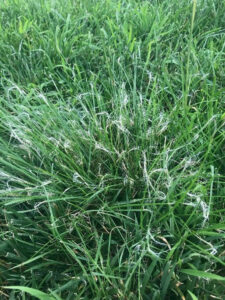
This picture displays frayed grass blades from a dull mower blade.
Mowing Blades
You may have already been mowing this season but, make sure that you have the mower blades sharpened regularly and you also perform regular maintenance on your mower like changing the oil and spark plugs regularly. Dull mower blades can tear, bruise and shred the grass blade causing injury to the turf. It can weaken the grass plant, and an open wound on grass blades are excellent spots for disease.
Other Best Practices
We also recommend not mowing your lawn when the grass is wet. Dew or any type of excessive moisture on the grass blades is an excellent way to spread lawn diseases. Also, avoid mowing midday in the full heat of the day because it can place extra stress on the plant. Mow in the cool of the morning after the dew has evaporated, or in the evening.
When mowing the lawn also try to change up the direction you typically mow. Mowing the lawn in same direction every time will cause the grass to lean that way. Mowing in different directions each time you cut the lawn will help the grass grow more upright.
Do not bag your grass clippings because leaving the clippings behind is beneficial for the lawn. This is a process called “grass-cycling”. The benefits of this process are that it puts moisture and nutrients back into the lawn. Contrary to popular belief it does not contribute to thatch build up. Sometimes bagging or removing clippings is unavoidable. If the clippings are too plentiful or too long and clump up, those should be removed. If left in clumps the grass underneath can suffocate and die off.
Conclusion
By following our best practices, like proper grass mowing height, you can reduce various problems in your lawn. Maintaining a lawn and landscape can take a lot of effort and a great amount of knowledge. If you have any questions regarding best mowing practices, please request an estimate or give our office a call at 908-281-7888.
Soil pH and Lime: How Lime Affects your Soil
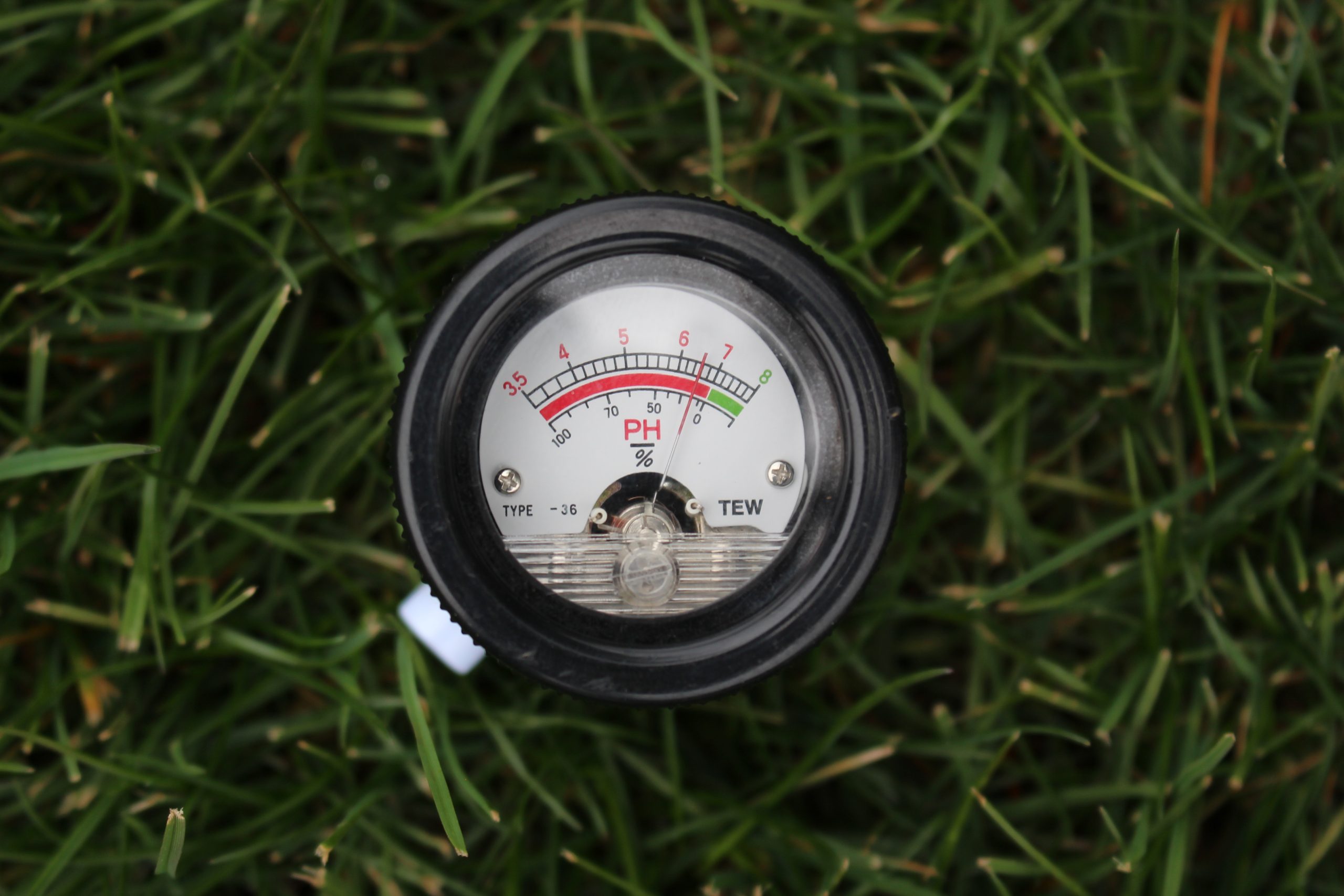
What is pH?
Soil pH is the measure of its acidity or alkalinity and is rated on a simple logarithmic scale. The scale represents hydrogen ion concentration and ranges from 0.0-14.0, with 0 being the most acidic and 14 being the most alkaline. The halfway point on the scale, 7.0, is neutral. Soil acidity increases as values decrease from 7.0 to 0.0, and soil alkalinity increases as pH values increase from 7.0-14.
What causes the pH of the soil to be acidic?
The soils of the northeastern region of the United States tend to be naturally acidic. The amount of annual rainfall largely determines whether soils will become acidic, neutral, or alkaline. In regions of high rainfall, such as here in New Jersey, the alkaline elements are leached deep into the lower soil regions by percolating rain water. This natural process leads to acidic soils.
Along with rainfall, there are other factors that will affect soil pH. Removal of grass clippings that contain alkaline elements, instead of allowing them to decompose into soil, will promote acidity. Leaves, pine needles, and other plant matter can create more acidic soil conditions as they decompose, and living plants will feed on alkaline elements (potassium, calcium, and magnesium). For these reasons, areas under dense tree cover or anywhere grass and tree roots compete for soil nutrients tend to have more acidic soil.
Why does the soil pH matter?
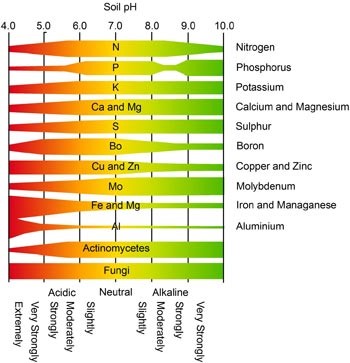 Knowing the soil pH is crucial because it strongly effects grass growth. Soil pH dictates nutrient availability, elemental toxicity, and microbial activity.
Knowing the soil pH is crucial because it strongly effects grass growth. Soil pH dictates nutrient availability, elemental toxicity, and microbial activity.
Various mineral nutrients are readily available in varying concentrations depending on the pH of the soil. At certain critical levels, some of the minerals remain bound to other minerals and are unavailable for plant use. The chart is a general representation of plant nutrient availability based on soil pH levels. The narrow areas of each band represent low availability of that nutrient, while the taller areas represent optimal nutrient availability.
The chart clearly illustrates that between a pH of 6.0-7.0, availability is at its peak for most of the critical lawn nutrients. The other thing to observe is that at about 5.5, nutrient availability becomes problematic and only gets worse as the soil becomes more acidic. Likewise, as the soil becomes more alkaline than 7.0, nutrient availability will also begin to suffer. However, soils with a pH of 7.0 or more are very rare in New Jersey, so the concern is normally in keeping lawn soil as alkaline as possible. The chart is not specific to our grass types, for typical cool season grasses found in New Jersey, the recommend pH level for optimal nutrient availability is between 6.3 and 6.5.
In addition to increased soil nutrient availability at a range of 6.0-7.0, this is also the range at which microorganism activity starts to peak. On the above chart the line labeled actinomycetes illustrates this point. Actinomycetes are bacteria in the soil responsible for the breakdown of a lot of organic matter as well as complex soil nutrients. Keeping the soil microorganisms as active as possible is of interest to the lawn care technician because they will help breakdown fertilizers into forms usable by plants, as well as keep thatch to a minimum by aiding in decomposition.
How can the pH be corrected?
Acidic soil pH can be corrected by applying lime. The most common liming materials are calcitic or dolomitic agricultural limestone. These are natural products made by finely grinding natural limestone. Since natural limestone is relatively water insoluble, agricultural limestone must be very finely ground so that it can mix with the soil particles and react with other nutrients to change soil acidity. The more finely ground the limestone is, the faster it will react in the soil. Both calcitic, and dolomitic lime contain calcium carbonate. Dolomitic lime however, also contains magnesium in the form of magnesium carbonate and should be used when soil tests indicate a magnesium deficiency.
Because high quality, finely ground limestone is very dusty and difficult to spread, some companies market a prilled or pelletized limestone for commercial and residential use. A small amount of clay or a polymer is added to the ground limestone so small prills are formed instead of dust. This makes it easier to apply out of a fertilizer spreader. Once applied, soil moisture will cause the granules to dissociate and disperse the limestone particles. Furthermore, newer pelletized lime products can be manufactured with reactants such as organic acids. These reactants speed up the chemical process by which lime changes soil pH, allowing for lawn applicators to produce quicker results, while using less product.
When using any limestone product, it is important to apply the material at the correct rate. Calcitic or dolomitic limestone, be it ground or pelletized, can have recommended application rates ranging anywhere from 5-200lbs/1000sq.ft. The rate at which the lime should be applied depends on the pH of the soil, what target range is trying to be obtained, and soil type.
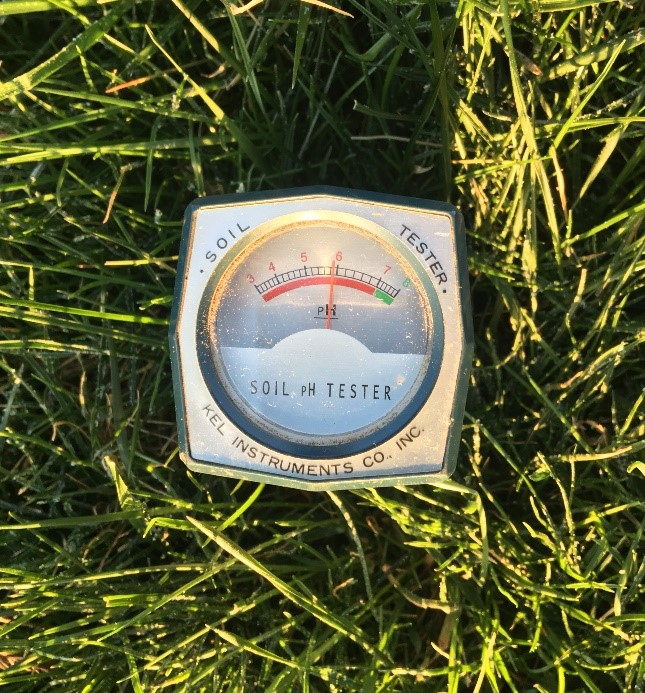 Optimum pH range in cool-season turf soil is between 6.3-6.5. At this range soil microbe activity and nutrient availability is high, and it provides the most optimum condition for the most desirable species of Kentucky bluegrass and perennial rye.
Optimum pH range in cool-season turf soil is between 6.3-6.5. At this range soil microbe activity and nutrient availability is high, and it provides the most optimum condition for the most desirable species of Kentucky bluegrass and perennial rye.
Soil type comes into play when determining lime application rate. Certain soil types will be more resistant to change in pH than others. In general, it is more difficult to change pH in clay soil than it is in sandy soil. When liming clay, higher lime amounts will be necessary to have the same effect that a smaller amount would have on sandy soils.
Before applying lime to an area, a test of the pH should be done. Soil pH should be measured at least once a year as a general practice. This can be done using any number of kits or through the use of a pH meter. The lower the pH, the more lime it will take to correct. For example, a soil with a pH of 4.5 will require significantly more lime to correct to 6.5 than a lawn with an initial pH of 6.0. It is for this reason that a pH reading should be taken at least once each year.
If severely low pH is suspected, a soil sample can be sent to a commercial or university lab. The results of the soil test will specify how much lime should be added in a single or multiple applications to correct the problem. In addition, any other nutrient deficiencies that may exist will be specified, and recommendations on treatment to correct these issues will be provided. Soil tests are a very accurate and a useful tool in determining hard to diagnose turf issues. However, soil test results take time and are an added expense, which is why they are less practical for determining pH on every lawn.
If you are in our service area and want to know more about liming your lawn or testing the pH, give our office a call at 908-281-7888. Also, you can learn more about our liming process from our website.



